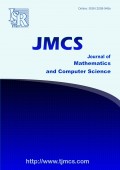Study the modified mathematical model of hepatitis B virus infection with immune response
Authors
E. M. Ahmed
- Department of Mathematics, Faculty of Sciences and Arts, King Abdulaziz University, Rabigh, Saudi Arabia.
N. H. Aljahdaly
- Department of Mathematics, Faculty of Sciences and Arts, King Abdulaziz University, Rabigh, Saudi Arabia.
Abstract
Hepatitis B is a viral infection caused by the hepatitis B virus (HBV), which primarily targets liver cells. Numerous studies in the literature have employed mathematical modeling to investigate the dynamics of HBV infection. This article develops a mathematical model that captures that captures the effects of the immune system response on uninfected cells as well as free viruses. The analysis of the model focuses on key mathematical properties, including positivity, boundedness, equilibrium points, the basic reproduction number (\(R_0\)), and local stability. Numerical simulations and sensitivity analyses are performed to further understand the model's behavior under various parameter settings. The results demonstrate that while the parameter representing the immune response’s effect on viral clearance does not alter (\(R_0\)), it has a significant impact on improving numerical outcomes. Sensitivity analysis reveals that an HBV outbreak can become widespread if certain parameters change. Specifically, a reduction in the rate of viral production by infected cells, the natural death rate of uninfected cells, and the natural death rate of free viruses increases the risk of the infection becoming a pandemic. Conversely, an increase in the growth rate of uninfected cells, the natural death rate of free viruses, and the probability of the virus successfully infecting uninfected cells and producing new infected cells, also contributes to the spread of the infection. These findings highlight the factors that influence the dynamics of HBV transmission.
Share and Cite
ISRP Style
E. M. Ahmed, N. H. Aljahdaly, Study the modified mathematical model of hepatitis B virus infection with immune response, Journal of Mathematics and Computer Science, 38 (2025), no. 3, 371--378
AMA Style
Ahmed E. M., Aljahdaly N. H., Study the modified mathematical model of hepatitis B virus infection with immune response. J Math Comput SCI-JM. (2025); 38(3):371--378
Chicago/Turabian Style
Ahmed, E. M., Aljahdaly, N. H.. "Study the modified mathematical model of hepatitis B virus infection with immune response." Journal of Mathematics and Computer Science, 38, no. 3 (2025): 371--378
Keywords
- Mathematical model
- theoretical analysis
- numerical solutions
- Hepatitis B
MSC
- 92C50
- 34D20
- 92D30
- 37N25
- 65L07
References
-
[1]
L. G. Guidotti, R. Rochford, J. Chung, M. Shapiro, R. Purcell, F. V. Chisari, Viral clearance without destruction of infected cells during acute HBV infection, Science, 284 (1999), 825–829
-
[2]
J. H. Hoofnagle, E. Doo, T. J. Liang, R. Fleischer, A. S. F. Lok, Management of hepatitis b: summary of a clinical research workshop, Hepatology, 45 (2007), 1056–1075
-
[3]
Z. Khatun, M. S. Islam, U. Ghosh, Mathematical modeling of hepatitis b virus infection incorporating immune responses, Sens. Int., 1 (2020), 8 pages
-
[4]
S. R. Lewin, R. M. Ribeiro, T. Walters, G. K. Lau, S. Bowden, S. Locarnini, A. S. Perelson, Analysis of hepatitis b viral load decline under potent therapy: complex decay profiles observed, Hepatology, 34 (2001), 1012–1020
-
[5]
L. Liu, X. Ma, Y. Li, X. Liu, Mathematical analysis of global dynamics and optimal control of treatment for an age-structured hbv infection model, Chaos Solitons Fractals, 177 (2023),
-
[6]
A. S Lok, E. J. Heathcote, J. H. Hoofnaglel, Management of hepatitis b: 2000—summary of a workshop, Gastroenterology, 120 (2001), 1828–1853
-
[7]
A. S. F. Lok, B. J. McMahon, Chronic hepatitis b, Hepatology, 45 (2007), 507–539
-
[8]
E. C. Manda, F. Chirove, Acute hepatitis B virus infection model within the host incorporating immune cells and cytokine responses, Theory Biosci., 139 (2020), 153–169
-
[9]
M. A. Nowak, S. Bonhoeffer, A. M. Hill, R. Boehme, H. C. Thomas, H. McDade, Viral dynamics in hepatitis b virus infection, Proc. Natl. Acad. Sci. USA, 93 (1996), 4398–4402
-
[10]
R. M. Ribeiro, A. Lo, A. S. Perelson, Dynamics of hepatitis b virus infection, Microbes Infect., 4 (2002), 829–835
-
[11]
S. W. Teklu, Analysis of hbv and covid-19 coinfection model with intervention strategies, Comput. Math. Methods Med., 2023 (2023), 17 pages
-
[12]
M .Tsiang, J. F. Rooney, J. J. Toole, C. S. Gibbs, Biphasic clearance kinetics of hepatitis b virus from patients during adefovir dipivoxil therapy, Hepatology, 29 (1999), 1863–1869
-
[13]
F. A. Wodajo, D. M. Gebru, H. T. Alemneh, Mathematical model analysis of effective intervention strategies on transmission dynamics of hepatitis b virus, Sci. Rep., 13 (2023), 21 pages
-
[14]
C. Xu, Y. Wang, K. Cheng, X. Yang, X. Wang, S. Guo, M. Liu, X. Liu, A mathematical model to study the potential hepatitis b virus infections and effects of vaccination strategies in china, Vaccines, 11 (2023), 20 pages

